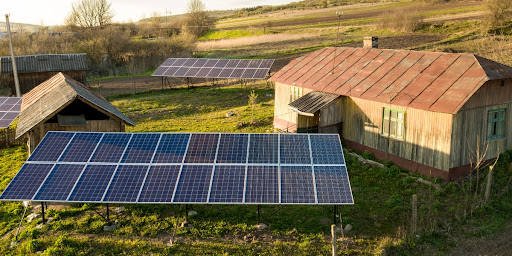At the Off-Grid Solar Works, we often discuss a “balanced” off-grid solar system. In this first post on the topic, we will focus on the energy components of a balanced system. An example chart, discussed below, was produced with the Off Grid Solar Works Estimator software. The Estimator is free to use for noncommercial DIY off-grid solar projects.
First, it is important to understand the basic vocabulary for energy. Energy is measured in watt hours (Wh); more often, it is kWh, which is simply 1,000 watt-hours. For example, a 100-watt appliance running for an hour would require 100-watt hours of energy; if it ran for 10 hours, it would require 1 kWh. Similarly, for solar production, a solar panel producing 300 watts (power) of electricity would produce 300 Wh (energy) in an hour. We will provide more details concerning solar panels and solar panel arrays in our next post.
A balanced solar system is critically important to how well your system will perform and how long it will last. The example System Balance chart below reflects the relationship between the three major energy components of the system: your daily energy consumption (i.e., your appliance load), the daily solar generation, and the battery capacity.
System Balance – Energy
The Load
The load requirement (red line in the chart) was estimated based on the appliance information that was entered in the Estimator. One of the most important considerations related to the load is lifestyle and, specifically, the appetite for energy management.
Energy Management
Appliances have a watt rating, which is the “given” part of the equation. Obviously, energy-efficient appliances are a good choice. However, the amount of time and time of day that the appliances will be used is just as important. These lifestyle questions are only now coming to the surface with grid-tied systems when customers are faced with Time of Use Charges (i.e., when the utility charges higher rates at different times of the day.)
In a DIY off-grid solar system, “energy management” is directly related to the amount of energy needed and, therefore, directly related to the size and cost of the system. Energy management deals with issues such as managing the use of appliances and managing the use of a generator. More details about generator use are planned for future posts.
The bottom line is that how you use your appliances is equally as important as how many appliances you have.
Solar versus Load
An important indicator of system balance shown in the chart is the relationship between the blue area (solar generation) and the red line. Note that the darker blue area in the chart reflects the estimated generation from solar panel bifacial gain. By the size of the bifacial gain shown in the chart, it is obvious that a ground-mounted array was planned.
The more the blue area is above the red line, the less dependence there will be on using a generator. Also, if the blue area is higher than the red line, then there is a daily surplus of solar energy (on an “average day”) to catch up with charging on a battery bank that is less than 100% charged at the end of the previous day.
As shown in the example chart, estimated solar production is less than the forecast energy consumption in December. This means there will be an increased need for generator support in December, which can be mitigated by increasing the size of the solar array. The estimates in the chart are daily averages, and there is no assurance that every day will be sunny, so a generator is always needed.
Battery versus Load
The third component of the chart is the black line indicating battery watt-hours. One key thing to look for here is the relationship between the black line (battery capacity) and the red line (energy consumption). If the black line is above the red line, then there is, on average, more than a full day of reserve energy stored in the battery bank when fully charged.
Final Remarks
Starting with the best strategy is fundamental to having a successful, cost-effective project. The ability to easily model different strategies and to evaluate easy-to-read, graphical results is a huge advantage. Whether you are planning your first DIY off-grid solar project or optimizing an existing one, using the Estimator can help streamline the process. Try it for your next project, and please let us know about your experience.




